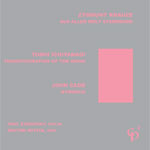Krauze's Aus aller Welt stammende is a four movement work based on four Polish folk melodies called "´swiatówki". The most important interpretative element in this composition is a rustic or folk-like style of playing. The players begin each section simultaneously but do not end it together...... Each instrumentalist plays independently of the others, and must concentrate exclusively on his own part; he should find his own tempo. Each section, including the final one, should be followed by ten seconds of complete silence, when all musicians remain motionless. (ZK)
The work (written in 1973) is originally scored for five solo violins, three solo violas, and two solo cellos - the first and last movement using all 10 players; the second movement using only 4 players; the third movement using 8. Given that the original has no frequency lower than the lowest open string of the violin, I asked the composer if I could perform the work using violins only. I was most pleased when Zygmunt allowed me to do so, as I feel that the consistency of the violins-only-timbre strengthens, rather than detracts from, the underlying thrust of the argument.
I first worked with Ichiyanagi in New York City, in the late 1950s when, as a studio pianist, during my lessons with Ivan Galamian, Toshi accompanied me in the Mendelssohn Concerto! In 1988, we did a collaborative concert tour in Japan, and it was an obvious to ask for a new work; but I asked for one involving a traditional Japanese instrument, both for the sonic variety of the tour, and as I love(d) the sounds they produce (I am still waiting for someone to write a work for violin and hichariki, as I would love to squawk with it)! Transfiguration of the Moon was the result of that request. Of the two-movement composition the composer writes:
The moon. Object of human dreams and imagination since ancient times. Material ground on which human beings actually descended and walked. Explored in all aspects through the various poetic forms, the moon seems to offer an infinite variety of moods, images, and inspirations, here reflected in the conversation between "sho" and violin.
When Cage was writing the original version of Hymnkus, he one day said to me (in response to my repeated requests for something violinistically much simpler than the Freeman Etudes (see the notes for CP2 #103), and knowing that I "liked" to record):
I have the perfect piece for you. I am writing a work with many parts. They are all single notes. We can make a version for violin; you can play all the parts; and you can record until you are blue in the face.
And so the multitrack violin version came into existence. In addition to the obvious instrumental changes, the original version included extraneous noise sounds integrated in to each part which, at my request, were changed to approximate pitches.
My having overdubbed, John & I arrived at the mixing session, and as usual, there arose between us a philosophical difference (it was these differences, and the discussions/arguments that they engendered, that made working with Cage such an intellectual blessing). John wanted what I thought of as a most conventional mix - that is to say, a scatter of sound sources across a broad sonic field. I had a quite different vision. I wanted some version of a sonic "black hole"; a tiny point where all parts would grind down into a single compound obsidian that might have different surfaces, and different reflectivities, but the components of which could not only not be distinguished, but would cease to have any individuality whatsoever (i.e. having removed virtually all (instrumental) timbral differences, which was perhaps the distinguishing characteristic of the original version, why not go "all the way")? Sadly, I could only (very) partially achieve what I wanted, as even a completely monaural mix still gave the impression of a sonic landscape too broad, and one would need the capabilities of an anechoic chamber in order to perhaps achieve the result I desired. So after years of internal fussing I decided on a compromise: I would release John's mix, as that is what the composer wanted, and as he was pleased with it; but I would also include the attempt at my preferred version, in order to present a vague idea of my conception. Given the finite duration of an audio CD, only 10 minutes of the "PZ Mix" is included as part of the audio portion of the CD, but the entire appears in the ENHANCED CD section of the disc.
There is an aspect of Hymnkus - a neologism combining the words Hymn (because of the repeated "verses") and (Hai)kus (as each verse contains 17 "syllables") - that bears especial mention. When he was writing Ten (1991), Cage told me that he felt he had made a return to harmony. In my opinion, perhaps that journey started with Hymnkus. It is not just that all of the individual parts are restricted in frequency range to the same perfect fifth. Far more importantly, there are statistical prevalences of certain frequencies, which prevalences change over time, so that if one listens very closely, one can almost sense an inexorable shift of underlying attractants or pitch centers which exert centripetal force, something conceptually not that far from aspects of traditional harmony. Hymnkus may therefore be an unintended pivotal work in Cage's late thinking about the function of harmony in music.
(PZ, April 2007)
TRACK LISTING
|
ZYGMUNT KRAUZE
AUS ALLER WELT STAMMENDE |
| 1. |
I |
|
(5:01) |
| 2. |
II |
|
(4:25) |
| 3. |
III |
|
(2:58) |
| 4. |
IV |
|
(6:11) |
TIME = 19:05 |
|
TOSHI ICHIYANAGI
TRANSFIGURATION OF THE MOON
MAYUMI MIYATA, SHO
|
| 5. |
I |
Lento sostenuto |
(6:06) |
| 6. |
II |
Adagio |
(7:19) |
TIME = 13:38 |
JOHN CAGE
HYMNKUS
|
| 7. |
|
Zukofsky Mix, excerpt |
(10:00) |
| 8. |
|
Cage mix |
(30:06) |
PAUL ZUKOFSKY, VIOLIN
|
TOTAL TIME = 73:20
|
CP2 Recordings
Zygmunt Krauze: (1938--) AUS ALLER WELT STAMMENDE
Publisher: PWM Edition, [Krakow], Moeck Verlag, Celle.
Toshi Ichiyanagi: (1933--) TRANSFIGURATION OF THE MOON
Publisher: composer's manuscript; presently Schott Japan Co., Ltd.
John Cage: (1912 - 1992) HYMNKUS (version for violin)
Publisher: violin version, composer¹s manuscript; original version, C.F. Peters
The Krauze was recorded at Hip Pocket Studios, N.Y.C., on Dec. 10 1993.
It was mixed in 2005 at SoundByte Productions, Inc., N.Y.C.
Produced & Engineered by Paul Zinman. Assistant Engineer: Gerry Volkerz.
The Ichiyanagi was recorded at Master Sound, Astoria, N.Y.C., on Feb. 26, 1995.
Produced & Engineered by Paul Zinman. Assistant Engineer: David Merrill.
The Cage was recorded at Hip Pocket Studios, N.Y.C. in Nov. & Dec., 1991.
It was mixed Dec. 21, 1991 at New York Digital Recording, Inc., N.Y.C.
Produced & Engineered by Paul Zinman. Assistant Engineer: Gerry Volkerz.
All edit choices: Paul Zukofsky
All Pre and Post-production supervision: Paul Zukofsky
CP2 122
© 2007 Musical Observations, Inc.
Mfg. by Musical Observations, Inc.
For information regarding our other releases, or Musical Observations, Inc.
activities in general, please visit our website at www.musicalobservations.com.
|



